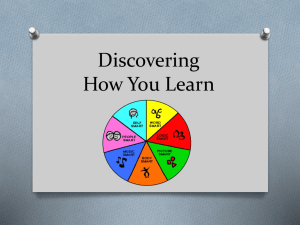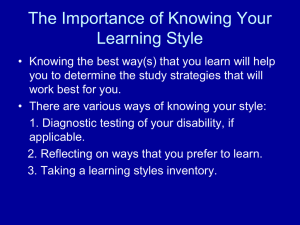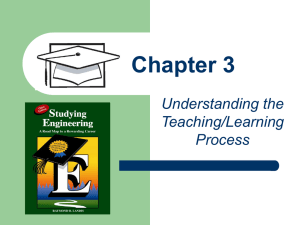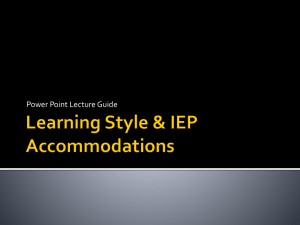Presentation Slides
advertisement
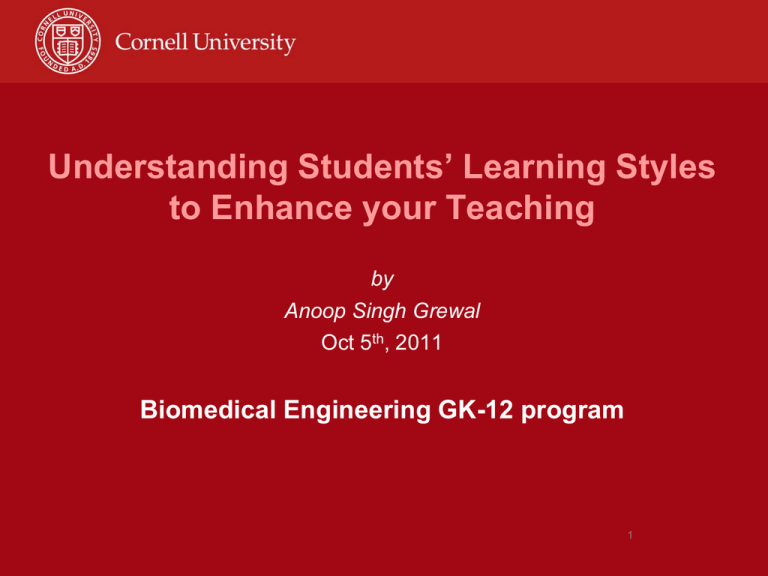
Understanding Students’ Learning Styles to Enhance your Teaching by Anoop Singh Grewal Oct 5th, 2011 Biomedical Engineering GK-12 program 1 PLEASE SHARE - Your name. - How do you think you learn best. - What kind of presentations techniques really get to you during a class room. 2 By end of this workshop, you will … • Gain insight into your preferred learning styles • Discover the different varieties and flavors of learning styles • Learn how to incorporate them in a class room 3 What is a learning style? Learning styles are various approaches of taking in, organizing and processing stimuli or information. They involve educating methods, particular to an individual, that are presumed to allow that individual to learn best. 4 Discover your personal learning style • Take ~ 5 min to fill out this quiz: – www.vark-learn.com/english/page.asp?p=questionnaire • Key is at the end. 5 Matching learning styles • Find people who scored the highest in the same category as you – Get together and discuss ways you prefer to learn – Generate a list to answer the following: • What kind of class activities/presentations appeal to you? • How do you prefer to study? 6 Overview of different styles Fleming’s VARK model 1. Visual learners 2. Auditory learners 3. Reading/writing-preference learners 4. Kinesthetic learners 7 Visual Learners • • • • • Pictures, plots, charts, diagrams Films, demonstrations Memorize by visualizing the information (e.g. words) Like making illustrations in notes Concept maps. 8 Concept Maps about Concept Maps 9 Auditory Learners • • • • Listening to lectures, not reading books Listening to music, etc - while studying Reading out aloud to themselves Oral exams 10 Read/Write Preference • • • • Written explanations Reading books Written notes Post-it everywhere NB: Many don’t include this as a separate category and call the rest as VAK model 11 Kinesthetic Learners • • • • Learn by doing things Have difficulty sitting passively through lectures Move around while revising things Like experiments, group activities etc. 12 Other styles [1/3] Sequential Learners Global Learners Prefer a linear, step-by-step Absorb information almost process (e.g: kids’ learning) randomly without seeing the connections, then suddenly “get it” 13 Other styles [2/3] Sensing Learners (concrete) • Like to solve facts • Prefer to use well-established methods Intuitive Learners (abstract) • Prefer discovering possibilities and relationships • Like innovation and dislike repetition • Are patient with details and good at memorizing facts • Grasp abstract concepts easily but have difficulty memorizing • Prefer observable, concrete facts information 14 Other styles [3/3] Active Learners • Same as kinesthetic Reflective Learners • Think about information before applying it • Understand by doing • Prefer working alone • Prefer working in groups • Have difficulty sitting passively through lectures • Have less difficulty sitting through lectures 15 Are there other styles? • Kolb’s Model: Kolb, David (1984). Experiential learning: Experience as the source of learning and development. Englewood Cliffs, NJ: Prentice-Hall. • Want to learn more about your learning style, personality style, brain dominance…check out this resource and try some quizzes – http://appl003.lsu.edu/cas/learningjourney.nsf/StudentHome? OpenForm – http://www.youtube.com/watch?v=vU5LoCLGMdQ 16 Mini lesson • Make mixed groups • For one of the topics listed, generate a lesson plan that appeals to all of your learning styles • Be prepared to share! How to… Balance a chemistry equation Score a game of bowling Organize a research paper Determine a property’s value Read music Conserve energy in your home Organize a CV or resume Keep your body healthy Say a phrase in a foreign language Understand a wine bottle label How… the respiratory system works Photosynthesis works Sound waves travel A computer works An electrical circuit works Explain… The US electoral college Currency valuation The parts of a cell Any other concept, process, or term! 17 17 What is this? http://www.youtube.com/watch?v=O4f4rX0XEBA&feature=related 18 18 Conclusions Please share: – Any students with new perspective ? about your own learning OR teaching others 19 Conclusions Remember that everyone falls in a unique place in the spectrum of learning styles 20 Conclusions Varying your instructional methods will help meet your students’ diverse learning needs. 21 Conclusions •Don’t change everything! • People are a mix of various styles. •Just try one unique activity at a time and see what works best for you and your class. 22 More resources: see handouts • Vark learning quiz: www.vark-learn.com/english/page.asp?p=questionnaire. • Learning activities: http://www4.ncsu.edu/unity/lockers/users/f/felder/public/ILSdir/styles.htm. • LSU website for learning strategies and more: http://appl003.lsu.edu/cas/learningjourney.nsf/StudentHome?OpenForm. • A great discussion on how to appeal to specific learning styles: http://www2.gsu.edu/~dschjb/wwwmbti.html. • A recent article about the design of a Web-based Educational system with Learning Style Adaptation. (available through Cornell): Popescu, E. J. of Computer Assisted Learning, 2010, 26, 243. • A recent article highlight some of the skepticism about learning styles. Martin, S. Teaching and Teacher Education, 2010, 26, 1583. 23 23
